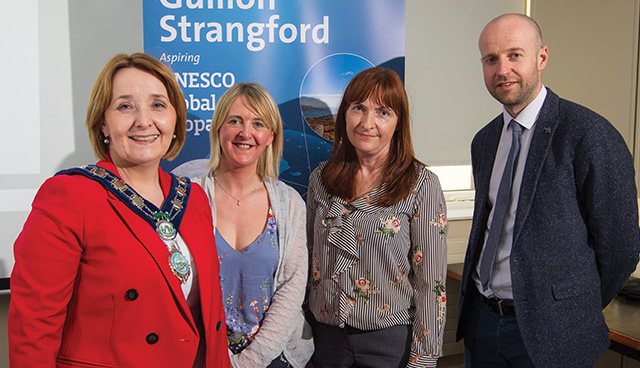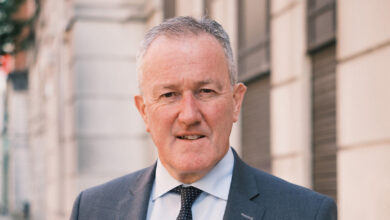Harnessing geotourism


Geotourism has the capacity to become a key sector in the transformation of Northern Ireland and to contribute significantly to economic growth. This will only happen if collectively we develop and market a world class visitor experience, continually strive to provide a high quality and competitive product and do so in a sustainable way.
Overseas tourism has expanded significantly in recent years with the total number of overseas visits to Ireland in 2016 amounting to almost 19 million. Ireland’s green landscapes and heritage make it a major geotourism and geoheritage destination.
Tourism in Northern Ireland currently generates revenue of close to £1 billion. In 2017, the top Northern Ireland tourist attraction was the Giant’s Causeway with one million visitors, the first time a tourist attraction in Northern Ireland reached that milestone. Tourism is an export opportunity, allowing us to bring out of state income to our economy.
Many people may not be aware but the Giant’s Causeway was the first World Heritage site in Northern Ireland. Designated a United Nations Educational, Scientific and Cultural Organization (UNESCO) World Heritage site in 1986, this title has brought with it global recognition and importance.
Seeking to replicate this success, Newry, Mourne and Down District Council is exploring the tourism potential associated with securing UNESCO Global Geopark status as it works to establish a UNESCO Global Geopark for three Areas of Outstanding Natural Beauty (AONB): Strangford Lough and Lecale; Ring of Gullion; and the Mourne Mountains.
At present there are 140 UNESCO Global Geoparks in 38 countries around the world, all of which have been developed using a bottom-up approach involving local communities. The UNESCO Global Geopark brand has benefited these communities. Research undertaken in the UK found that the UNESCO label added an average of £2.69 million to the UK economy per annum for each UNESCO Global Geopark.
So, what is a UNESCO Global Geopark?
UNESCO Global Geoparks are single, unified geographical areas where sites and landscapes of international, geological significance are managed with a holistic concept of sustainable development, education and protection.
A UNESCO Global Geopark uses its geological heritage, in connection with all other aspects of the area’s natural and cultural heritage, to enhance awareness and understanding of key issues facing society, such as, using our earth’s resources sustainably, mitigating the effects of climate change and reducing natural disasters-related risks.
By raising awareness of the importance of the area’s geological heritage, UNESCO Global Geoparks give local people a sense of pride in their region and strengthen their identification with the area. The creation of innovative local enterprises, new jobs and high-quality training courses is stimulated as new sources of revenue are generated through geotourism, while the geological resources of the area are protected.
UNESCO Global Geoparks are established through a bottom-up process involving local stakeholders in the area. This process requires firm commitment by the local communities, a strong local multiple partnership with long-term public and political support, and the development of a comprehensive strategy that will meet all of the communities’ goals while showcasing and protecting the area’s geological heritage.
Newry, Mourne and Down District Council Chairperson, Councillor Roisin Mulgrew explains: “UNESCO Global Geopark status for the area will play a key role in differentiating the region and in giving it a much stronger and cohesive market identity. The proposed UNESCO Global Geopark will bring significant economic benefits while empowering local communities, giving them the opportunities to develop cohesive partnerships using the geological heritage to provide recreational opportunities, generate economic benefits and increase awareness of the area’s natural assets.
“The UNESCO Global Geopark brand does not impose any restrictions on farming practices, planning or development. All the proposed sites to be included have public access already in place. Typical activities in a UNESCO Global Geopark include walking and cycling trails, the training of local people to act as guides, provision of information signage and the development of visitor centres. The ultimate aim is to enhance the economy and develop employment opportunities for the people who live there.”
The Application process
There is a programme of work involved in securing UNESCO Global Geopark status and activity has started to allow an application to be submitted to UNESCO for consideration.
Mulgrew adds: “This application will ensure an ongoing emphasis on developing geotourism, while the underlying ethos of UNESCO Global Geoparks will support the direction of the Newry, Mourne and Down District Council Tourism Strategy 2017-2021, which explores, develops and identifies links between the geological heritage, and all other aspects of the area’s abundant heritage assets.
“Stakeholder engagement has been ongoing. Events have been organised to allow local residents to meet representatives from the team involved in the application and put questions to them, while a public roadshow was held to mark ‘European Geoparks Week’. Further engagement events are planned to ensure people fully understand the benefits associated with the UNESCO brand.”
Dr Kirstin Lemon from the Geological Survey of Northern Ireland (GSNI) discusses the area’s geological history and the unique qualities which make it an ideal candidate for UNESCO Global Geopark status: “The unique geological heritage of the area spans over 400 million years of history. The proposed UNESCO Global Geopark area will use the rocks and landscapes to tell a tale of two oceans; one that has long since disappeared, and one that has ‘recently’ opened.
“There are currently three UNESCO Global Geoparks on the island of Ireland; Burren and Cliffs of Moher UNESCO Global Geopark in County Clare, Copper Coast UNESCO Global Geopark in County Waterford and Marble Arch Caves UNESCO Global Geopark in County Fermanagh and County Cavan. “The Marble Arch Caves is the first cross-border geopark in the world, and is estimated to generate approximately £15.2 million per year to the surrounding economy. The Marble Arch Caves UNESCO Global Geopark also attribute the success of secured EU funding (€12m) since 2001 entirely to their UNESCO Global Geopark status.”
Lemon adds: “Research undertaken by Indecon on behalf of the Geological Survey of Ireland estimated that 4.5 million tourists visited fee-paying geotourism sites in 2016, including the Cliffs of Moher, part of the Burren and Cliffs of Moher UNESCO Global Geopark. Based on the entry fee to geotourism sites, Indecon attributed a figure of €33.56 million to fee-paying geotourism sites in 2016.
“The financial benefit of UNESCO membership to the UK’s 180 UNESCO affiliated organisations is an estimated £90 million per year.”
For further information:
www.unesco.org
www.newrymournedown.org







